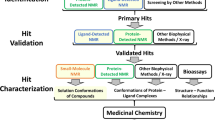Abstract
Nuclear magnetic resonance (NMR) spectroscopy is a powerful tool for the structure elucidation of antibiotics in solution. Over the past 30 years there have been numerous publications describing the use of NMR to characterize naturally derived or synthetic antibiotics. A large number of one-dimensional (1D) and two-dimensional (2D) NMR methods are available today and the list continues to expand. In this chapter, we will consider the key NMR experiments that provide useful information for compound structure elucidation.
The original version of this chapter was revised. The erratum to this chapter is available at: DOI 10.1007/978-1-4939-6634-9_21
Access this chapter
Tax calculation will be finalised at checkout
Purchases are for personal use only
Similar content being viewed by others
References
Lewis K (2013) Platforms for antibiotic discovery. Nat Rev Drug Discov 12:371–387
Blair JMA, Webber MA, Baylay AJ et al (2015) Molecular mechanisms of antibiotic resistance. Nat Rev Microbiol 13:42–51
Clardy J, Fischbach MA, Walsh CT (2006) New antibiotics from bacterial natural products. Nat Biotechnol 12:1541–1550
Harvey AL, Edrada-Ebel R, Quinn RJ (2015) The re-emergence of natural products for drug discovery in the genomics era. Nat Rev Drug Discov 14:111–129
Koehn FE, Carter GT (2005) The evolving role of natural products in drug discovery. Nat Rev Drug Discov 4:206–220
Ibrahim SRM, Min CC, Teuscher F et al (2010) Callyaerins A-F and H, new cytotoxic cyclic peptides from the Indonesian marine sponge Callyspongia aerizusa. Bioorg Med Chem 18:4947–4956
Daletos G, Kalscheuer R, Koliwer-Brandl H et al (2015) Callyaerins from the marine sponge Callyspongia aerizusa: cyclic peptides with antitubercular activity. J Nat Prod 78:1910–1925
Bara R, Zerfass I, Aly AH et al (2013) Atropisomeric dihydroanthracenones as inhibitors of multiresistant Staphylococcus aureus. J Med Chem 56:3257–3272
Molinski TF (2010) NMR of natural products at the ‘nanomole-scale’. Nat Prod Rep 27:321–329
Breton RC, Reynolds WF (2013) Using NMR to identify and characterize natural products. Nat Prod Rep 30:501–524
Simpson JH (2008) Organic structure determination using 2-D NMR spectroscopy: a problem-based approach. Elsevier, Acad Press, Amsterdam [et al]
Ning Y-C (2011) Interpretation of organic spectra. Wiley, Hoboken, New Jersey
Crews P, Rodríguez J, Jaspars M (2010) Organic structure analysis. International, 2nd edn. Oxford University Press, New York
Lambert JB, Gronert S, Shurvell HF, Lightner DA (2011) Organic structural spectroscopy, 2nd edn. Pearson Prentice Hall, Boston [et al]
Matsumori N, Kaneno D, Murata M et al (1999) Stereochemical determination of acyclic structures based on carbon-proton spin-coupling constants. A method of configuration analysis for natural products. J Org Chem 64:866–876
Richards SA, Hollerton JC (2011) Essential practical NMR for organic chemistry. Wiley, Chichester
Pham C-D, Weber H, Hartmann R et al (2013) New cytotoxic 1,2,4-thiadiazole alkaloids from the ascidian Polycarpa aurata. Org Lett 15:2230–2233
Marfey P (1984) Determination of D-amino acids. II. Use of a bifunctional reagent, 1,5-difluoro-2,4-dinitrobenzene. Carlsberg Res Commun 49:591–596
Acknowledgment
This work was supported by the German Federal Ministry of Education and Research (BMBF; Bundesministerium für Bildung und Forschung).
Author information
Authors and Affiliations
Corresponding authors
Editor information
Editors and Affiliations
Rights and permissions
Copyright information
© 2017 Springer Science+Business Media New York
About this protocol
Cite this protocol
Daletos, G., Ancheeva, E., Orfali, R.S., Wray, V., Proksch, P. (2017). Structure Elucidation of Antibiotics by NMR Spectroscopy. In: Sass, P. (eds) Antibiotics. Methods in Molecular Biology, vol 1520. Humana Press, New York, NY. https://doi.org/10.1007/978-1-4939-6634-9_4
Download citation
DOI: https://doi.org/10.1007/978-1-4939-6634-9_4
Published:
Publisher Name: Humana Press, New York, NY
Print ISBN: 978-1-4939-6632-5
Online ISBN: 978-1-4939-6634-9
eBook Packages: Springer Protocols




